False-Positive Human Immunodeficiency Virus Results in COVID-19 Patients
- PMID: 36843732
- PMCID: PMC9946275
- DOI: 10.7759/cureus.34096
False-Positive Human Immunodeficiency Virus Results in COVID-19 Patients
Abstract
The severe acute respiratory syndrome coronavirus 2 (SARS-CoV-2) virus, which causes coronavirus disease 2019 (COVID-19) disease, was first described in 2019 and became a pandemic in 2020. Although it is possible for two viruses to co-infect together, a rarer phenomenon of false-positive results due to cross-reactivity between viruses is also possible. Herein, we present two cases of the false-positive human immunodeficiency virus (HIV) results in those infected with COVID-19. Both patients were screened for HIV and were initially found to be positive with the fourth-generation test. A subsequent blood test revealed no viral load, and an enzyme-linked immunosorbent assays (ELISA) test indicated no reactivity to HIV, thus the false initial screening test. SARS-CoV-2 is an enveloped RNA virus with its outer surface containing a spike-like glycoprotein, which allows it to recognize host cells and invade. HIV-1 gp41 and SARS-CoV-2 share several structural sequences and motifs. These similarities could explain cross-reactivity and false-positive results when screening for HIV in the presence of COVID. The presence of HIV must be confirmed through more specific laboratory tests such as ELISA.
Keywords: covid-19; enzyme linked immunosorbent assay (elisa); fourth generation hiv screening test; human immunodeficiency virus infection; sars-cov-2.
Copyright © 2023, Hakobyan et al.
Conflict of interest statement
The authors have declared that no competing interests exist.
Figures



Similar articles
-
A Method To Prevent SARS-CoV-2 IgM False Positives in Gold Immunochromatography and Enzyme-Linked Immunosorbent Assays.J Clin Microbiol. 2020 May 26;58(6):e00375-20. doi: 10.1128/JCM.00375-20. Print 2020 May 26. J Clin Microbiol. 2020. PMID: 32277023 Free PMC article.
-
Potential Antigenic Cross-reactivity Between Severe Acute Respiratory Syndrome Coronavirus 2 (SARS-CoV-2) and Dengue Viruses.Clin Infect Dis. 2021 Oct 5;73(7):e2444-e2449. doi: 10.1093/cid/ciaa1207. Clin Infect Dis. 2021. PMID: 32797228 Free PMC article.
-
False-positive HIV in a patient with SARS-CoV-2 infection; a case report.Ann Med Surg (Lond). 2021 Nov;71:103027. doi: 10.1016/j.amsu.2021.103027. Epub 2021 Nov 6. Ann Med Surg (Lond). 2021. PMID: 34777794 Free PMC article.
-
Increase in False-Positive Fourth-Generation Human Immunodeficiency Virus Tests in Patients With Coronavirus Disease 2019.Clin Infect Dis. 2023 Aug 22;77(4):615-619. doi: 10.1093/cid/ciad264. Clin Infect Dis. 2023. PMID: 37158382 Free PMC article.
-
[SARS-CoV-2 and Microbiological Diagnostic Dynamics in COVID-19 Pandemic].Mikrobiyol Bul. 2020 Jul;54(3):497-509. doi: 10.5578/mb.69839. Mikrobiyol Bul. 2020. PMID: 32755524 Review. Turkish.
Cited by
-
False-Positive Screening and Confirmatory HIV Diagnostic Test in a Patient with Cured SARS-CoV-2 Infection Is Not Mediated by Env/Spike Cross-Reactive Antibodies.Viruses. 2023 May 13;15(5):1161. doi: 10.3390/v15051161. Viruses. 2023. PMID: 37243248 Free PMC article.
-
COVID-19 infection and a repeated false positivity effect in HIV testing: A case report.IDCases. 2023 Oct 8;34:e01908. doi: 10.1016/j.idcr.2023.e01908. eCollection 2023. IDCases. 2023. PMID: 37860150 Free PMC article.
References
Publication types
LinkOut - more resources
Full Text Sources
Miscellaneous
